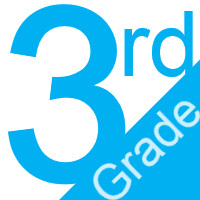3rd Grade English
Completion requirements
 Prioritized Standards
Prioritized Standards
 Standards Glossaries
Standards Glossaries
| K Grade English | 1st Grade English | 2nd Grade English |
 Standards Glossaries
Standards Glossaries
| 3rd Grade English | 4th Grade English | 5th Grade English |
 Standards Glossaries
Standards Glossaries
| 6th Grade English | 7th Grade English | 8th Grade English |
 Standards Glossaries
Standards Glossaries
| 9th Grade English | 10th Grade English | 11th Grade English | 12th Grade English |
 Standards Glossaries
Standards Glossaries
| HS Journalism | HS Speech |
| (L) Language |
ELA-03.L.01ELA-03.L.01 Demonstrate command of the conventions of standard English grammar and usage when writing or speaking.Sub-Standards:
Introduce:
a. Produce complex and compound-complex sentences.
b. Form and use the progressive (e.g., I was walking; I am walking; I will be walking) verb tenses. c. Form and use the perfect (e.g., I had walked; I have walked; I will walk) verb tenses. d. Use helping and modal auxiliaries (e.g., can, may, must) to convey various conditions. e. Form and use prepositional phrases.
Practice:
f. Ensure subject verb-agreement.
g. Produce compound sentences. h. Produce complete sentences, recognizing and correcting inappropriate fragments and run-ons. i. Use regular plural nouns orally by adding /s/ or /es/. j. Form and use regular and irregular plural nouns. k. Use abstract nouns (e.g., childhood). l. Use possessive nouns. m. Form and use regular and irregular verbs. n. Form and use comparative and superlative adjectives and choose between them depending on what is to be modified. o. Form and use comparative and superlative adverbs and choose between them depending on what is to be modified.
Display proficiency in:
p. Correctly use common homophones (e.g., to, too, two; there, their).
q. Use singular and plural nouns with matching verbs in basic sentence (simple subject/verb agreement). r. Use collective nouns. s. Form and use the past tense of frequently occurring irregular verbs. t. Use verbs to convey a sense of past, present, and future. u. Use reflexive pronouns (e.g., myself, ourselves). v. Use demonstratives (that, those, these, this) w. Use adverbs depending on what is to be modified. x. Use and explain interjections Student Learning Targets:Knowledge Targets
Reasoning Targets
Skills (Performance) Targets
Proficiency ScaleThe Student Will ...1 Beginning... with help, demonstrates a partial understanding of some of the simpler details and processes (Score 2.0 content) and some of the more complex ideas and processes (Score 3.0 content).Start 2 Developing... demonstrates no major errors or omissions regarding the simpler details and processes but exhibits major errors or omissions regarding the more complex ideas and processes (Score 3.0 content).Simple 3 Proficient“The Standard.”... demonstrates no major errors or omissions regarding any of the information and processes that were end of instruction expectations. Target 4 Advanced... demonstrates in-depth inferences and applications regarding more complex material that go beyond end of instruction expectations.Complex ResourcesVocabulary
Websites
| |||
ELA-03.L.02ELA-03.L.02 Demonstrate command of the conventions of standard English capitalization, punctuation, and spelling when writing.Sub-Standards:
Introduce:
a. Use commas and quotation marks in dialogue.
b. Form and use possessives. c. Add prefixes and suffixes to base words (e.g., sitting, smiled, cries, happiness). d. Use commas and quotation marks to mark direct speech and quotations from a text. e. Use a comma before a coordinating conjunction in a compound sentence. f. Use punctuation to separate items in a series. g. Use a comma to separate an introductory element from the rest of a sentence. h. Use a comma to set off the words yes and no (e.g., Yes, thank you), to set off a tag
question from the rest of the sentence (e.g., It’s true, isn’t it?) and to indicate direct
address (e.g., Is that you, Steve?).
i. Use underlining, quotation marks, or italics to indicate titles of works. j. Spell grade-appropriate words correctly, consulting references as needed and/or using spelling patterns and generalizations (e.g., word families, position-based spelling, syllable patterns, ending rules, meaningful word parts).
Display proficiency in:
k. Use commas in greetings and closings of letters.
l. Use an apostrophe to form contractions and frequently occurring possessives. m. Generalize learned spelling patterns when writing words (e.g., cage → badge; boy → boil). n. Use commas in addresses. o. Use conventional spelling for high-frequency and other studied words. | |
ELA-03.L.03ELA-03.L.03 Use knowledge of language and its conventions when writing, speaking, reading, or listening.Sub-Standards:
a. Choose words and phrases for effect.
b. Recognize and observe differences between the conventions of spoken and written standard English.
Student Learning Targets:Knowledge Targets
Reasoning Targets
Skills (Performance) Targets
Proficiency ScaleThe Student Will ...1 Beginning... with help, demonstrates a partial understanding of some of the simpler details and processes (Score 2.0 content) and some of the more complex ideas and processes (Score 3.0 content).Start 2 Developing... demonstrates no major errors or omissions regarding the simpler details and processes but exhibits major errors or omissions regarding the more complex ideas and processes (Score 3.0 content).Simple 3 Proficient“The Standard.”... demonstrates no major errors or omissions regarding any of the information and processes that were end of instruction expectations. Target 4 Advanced... demonstrates in-depth inferences and applications regarding more complex material that go beyond end of instruction expectations.Complex ResourcesVocabulary
Websites
| |||
ELA-03.L.04ELA-03.L.04 Determine or clarify the meaning of unknown and multiple meaning words and phrases based on grade 3 reading and content, choosing flexibly from a range of strategies.Sub-Standards:
a. Use sentence-level context as a clue to the meaning of a word or phrase.
b. Determine the meaning of the new word formed when a known affix is added to a known word (e.g., agreeable/ disagreeable, comfortable/uncomfortable, care/careless, heat/preheat).
c. Use a known root word as a clue to the meaning of an unknown word with the same root (e.g., company, companion).
d. Use glossaries or beginning dictionaries, both print and digital, to determine or clarify the precise meaning of key words and phrases. Student Learning Targets:Knowledge Targets
Reasoning Targets
Skills (Performance) Targets
Proficiency ScaleThe Student Will ...1 Beginning... with help, demonstrates a partial understanding of some of the simpler details and processes (Score 2.0 content) and some of the more complex ideas and processes (Score 3.0 content).Start 2 Developing... demonstrates no major errors or omissions regarding the simpler details and processes but exhibits major errors or omissions regarding the more complex ideas and processes (Score 3.0 content).Simple 3 Proficient“The Standard.”... demonstrates no major errors or omissions regarding any of the information and processes that were end of instruction expectations. Target 4 Advanced... demonstrates in-depth inferences and applications regarding more complex material that go beyond end of instruction expectations.Complex ResourcesVocabulary
Websites
| |||
ELA-03.L.05ELA-03.L.05 Demonstrate understanding of word relationships and nuances in word meanings.Sub-Standards:
a. Distinguish the literal and nonliteral meanings of words and phrases in context (e.g., take steps).
b. Identify real-life connections between words and their use (e.g., describe people who are friendly or helpful).
c. Distinguish shades of meaning among related words that describe states of mind or degrees of certainty (e.g., knew, believed, suspected, heard, wondered).
Student Learning Targets:Knowledge Targets
Reasoning Targets
Skills (Performance) Targets
Proficiency ScaleThe Student Will ...1 Beginning... with help, demonstrates a partial understanding of some of the simpler details and processes (Score 2.0 content) and some of the more complex ideas and processes (Score 3.0 content).Start 2 Developing... demonstrates no major errors or omissions regarding the simpler details and processes but exhibits major errors or omissions regarding the more complex ideas and processes (Score 3.0 content).Simple 3 Proficient“The Standard.”... demonstrates no major errors or omissions regarding any of the information and processes that were end of instruction expectations. Target 4 Advanced... demonstrates in-depth inferences and applications regarding more complex material that go beyond end of instruction expectations.Complex ResourcesVocabulary
Websites
| |||
ELA-03.L.06ELA-03.L.06 Acquire and use accurately grade-appropriate general academic and domain-specific words and phrases, including those that signal contrast, addition, and other logical relationships (e.g., however, although, nevertheless, similarly, moreover, in addition).Student Learning Targets:Knowledge Targets
Reasoning Targets
Skills (Performance) Targets
Proficiency ScaleThe Student Will ...1 Beginning... with help, demonstrates a partial understanding of some of the simpler details and processes (Score 2.0 content) and some of the more complex ideas and processes (Score 3.0 content).Start 2 Developing... demonstrates no major errors or omissions regarding the simpler details and processes but exhibits major errors or omissions regarding the more complex ideas and processes (Score 3.0 content).Simple 3 Proficient“The Standard.”... demonstrates no major errors or omissions regarding any of the information and processes that were end of instruction expectations. Target 4 Advanced... demonstrates in-depth inferences and applications regarding more complex material that go beyond end of instruction expectations.Complex ResourcesVocabulary
Websites
| |||



 Grade 3
Grade 3